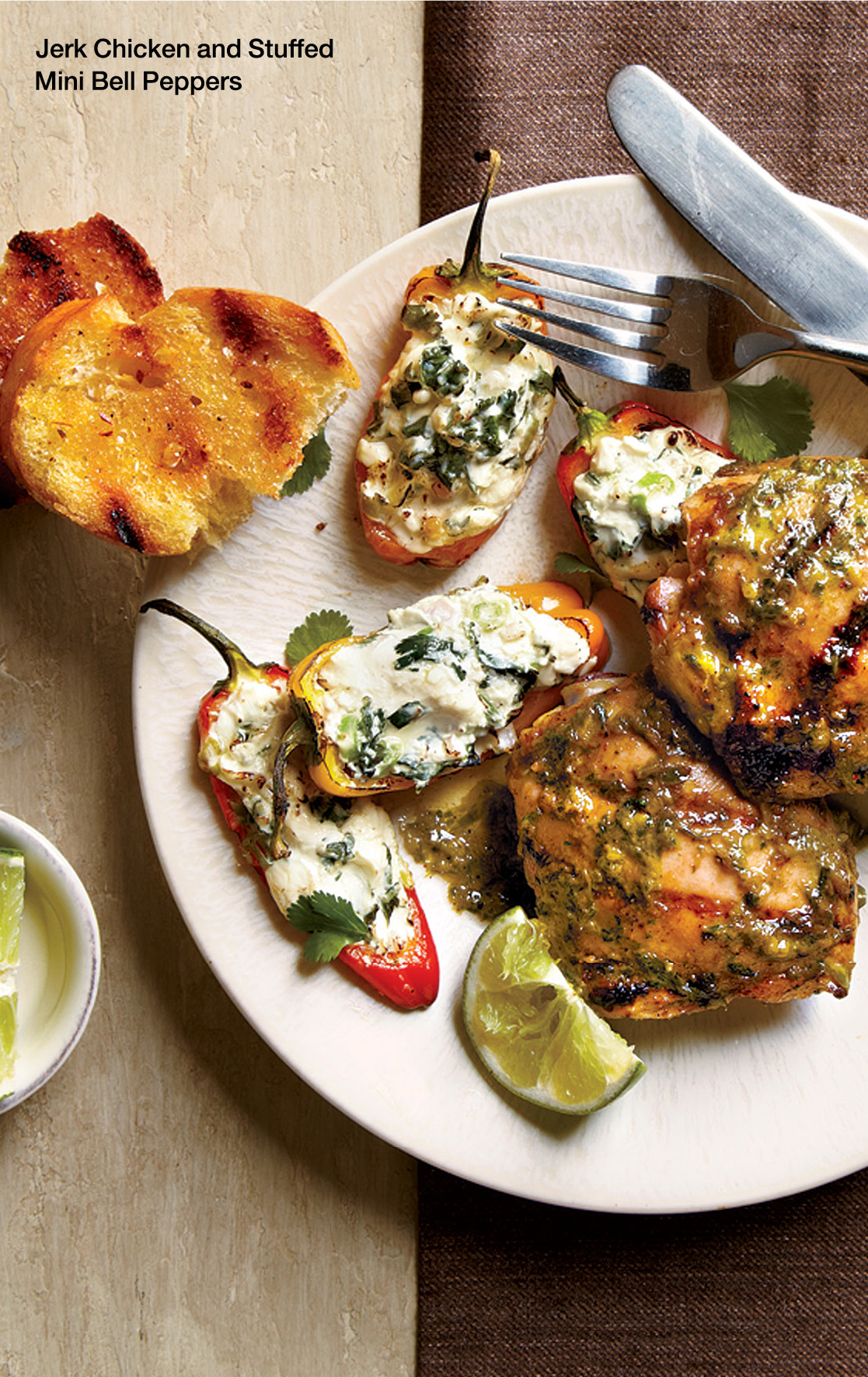

This recipe uses both hot and sweet garden peppers. Try those sweet little Yummy peppers (yes, that’s the real name) for the tongue-taming creamy stuffing. After eating the serrano-spiked jerk chicken, you’ll be glad you did.
1/3 cup sliced green onions, divided
1/3 cup chopped shallots, divided
1 tablespoon brown sugar
3 tablespoons fresh lime juice, divided
2 tablespoons olive oil
1/2 teaspoon ground allspice
4 garlic cloves
1 large serrano chile, stemmed
8 bone-in chicken thighs, skinned
1/4 teaspoon salt
Cooking spray
3 ounces 1/3-less-fat cream cheese (about 1/3 cup)
2 tablespoons chopped fresh cilantro
2 tablespoons light sour cream
8 mini bell peppers
1. Preheat grill to medium-high heat. After preheating, reduce heat on one side to low.
2. Place 1/4 cup green onions, 1/4 cup shallots, sugar, 2 tablespoons juice, oil, allspice, garlic, and serrano in a mini food processor; process until smooth. Combine half of onion mixture and chicken in a medium bowl; toss well. Sprinkle with salt.
3. Place chicken on grill rack coated with cooking spray over medium-high heat. Cover and grill 5 minutes on each side. Move chicken over low heat. Cover and grill 5 minutes on each side or until done. Brush chicken with remaining onion mixture.
4. While chicken cooks, combine remaining green onions, remaining shallots, 1 tablespoon juice, cheese, cilantro, and sour cream in a bowl. Halve bell peppers lengthwise; discard seeds. Divide cheese mixture evenly among pepper halves. Place peppers on grill rack coated with cooking spray over medium-high heat. Grill 7 minutes or until peppers are lightly charred. Serves 4 (serving size: 2 thighs and 4 pepper halves).
CALORIES 338; FAT 21.2g (sat 4.3g, mono 5.1g, poly 10.1g); PROTEIN 17.5g; CARB 22.6g; FIBER 4.9g; CHOL 72mg; IRON 2.6mg; SODIUM 535mg; CALC 197mg

Hot Pepper Overload
The bad thing about growing hot peppers is that one plant is so incredibly productive. The good thing about growing hot peppers is that one plant is so incredibly productive. You need just one or two to spice up a recipe. One solution for a plethora of peppers is to dry them in a dehydrator, string them, crush them with mortar and pestle, or powder them with a spice grinder—you’ll have a year’s supply of heat at your fingertips as crushed red pepper flakes or chili powder with your personal heat preference. Two tips: Use gloves and put the dehydrator in the garage, or else you’ll mace yourself!


This grilled veggie pizza is a gorgeous medley of red pepper, zucchini, mushrooms, red onion, and sweet basil. Also consider orange, yellow, or purple sweet peppers such as Merlot, Golden Treasures, or Canary Bell. With refrigerated fresh pizza dough and a few minutes on the grill, dinner is on the table in minutes.
2 portobello mushroom caps
1 tablespoon chopped garlic
1 large red bell pepper, cut into 1/2-inch strips
1 medium zucchini, cut diagonally into 1/2-inch-thick slices
1 red onion, cut into 1/2-inch wedges (root end intact)
5 teaspoons extra-virgin olive oil
1/4 teaspoon kosher salt
1/4 teaspoon freshly ground black pepper
Cooking spray
8 ounces refrigerated fresh pizza dough
4 ounces shredded fontina cheese (about 1 cup)
1/4 cup basil leaves
1/2 teaspoon crushed red pepper
1. Preheat grill to high heat.
2. Remove brown gills from undersides of mushrooms with a spoon; discard. Combine mushrooms, garlic, bell pepper, zucchini, onion, and oil in a bowl; toss to coat. Sprinkle with salt and pepper. Arrange vegetables on grill rack coated with cooking spray; grill 8 minutes or just until tender. Slice mushrooms.
3. Roll dough into a 12-inch oval on a lightly floured surface. Place dough on grill rack; grill 2 minutes on each side or until lightly browned.
4. Sprinkle cheese over dough, leaving a 1/2-inch border around edges. Arrange vegetable mixture over cheese. Grill pizza 3 minutes or until cheese melts. Sprinkle pizza with basil leaves and crushed red pepper; cut into 8 slices. Serves 4 (serving size: 2 slices).
CALORIES 344; FAT 16.1g (sat 6g, mono 6.5g, poly 2.2g); PROTEIN 14.2g; CARB 38g; FIBER 3.1g; CHOL 31mg; IRON 2.6mg; SODIUM 693mg; CALC 173mg


Season: New potatoes are available in late spring and early summer. Mature potatoes make their appearance in late summer and fall.
CHOOSING: Look for firm potatoes that are not green or sprouting.
Storing: Place potatoes in paper or burlap bags to increase the humidity while allowing air to circulate. Store them in the coolest, darkest place in your home, such as a pantry or cabinet or in an unheated garage or basement. They’ll last three to five weeks.
Growing: To plant potatoes, you need potatoes—but not ones from the grocery store. Instead, purchase seed potatoes that are raised carefully to be disease-free. If the seed potato is large, cut it into 1 1/4-inch pieces that each contain an eye (the bud that causes an indentation in the surface). Let the cut pieces air-dry for a day or two before planting.
Potatoes can tolerate cold soil and frosts, so plant in a sunny spot about two weeks before the last expected frost or as soon as the soil can be worked. Prepare the soil with plenty of compost to make it loose and fertile. There are a few planting options: The trench method involves setting the seed pieces 12 inches apart in a 6-inch-deep furrow, and then covering with about 3 inches of soil. Continue to bring the soil over the developing potatoes as the plant grows, always leaving the top leaves visible.
The labor-saving surface method involves pressing the seed pieces about a foot apart into a level bed until they’re almost buried, and then piling about 18 inches of leaves, straw, or other mulch on top on the bed. The mulch will settle and the potato foliage will find its way to the light. Harvesting the potatoes involves little more than pulling back the mulch and lifting the plant, potatoes attached.
You can also grow potatoes in a large container—think whiskey-barrel size. Set the seed potatoes on top of 6 inches of potting mix, and cover with a couple of inches of soil. As the potatoes grow, continue to add more potting mix and mulch until the pot is filled.
Harvesting potatoes is like digging for buried treasure. New potatoes are ready about two months after planting. For the final harvest, wait until the foliage is beginning to yellow. If you injure any potatoes with your digging fork, eat those first.
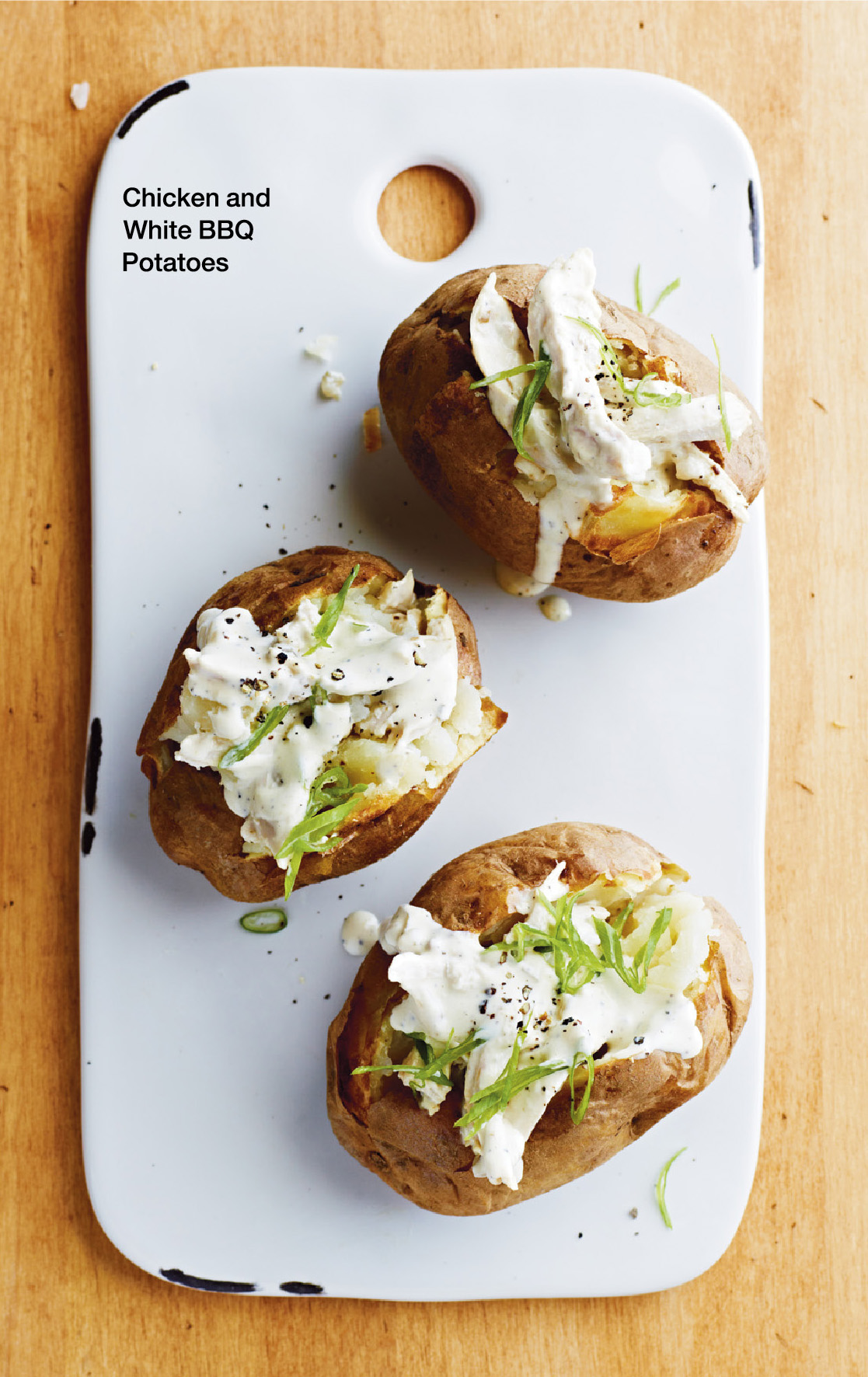
Potatoes are known to be versatile, but did you know they could house your entire dinner? This comfort classic has all the trimmings of a warm and filling meal. Scale down by using Yukon gold potatoes, which tend to be smaller than larger russet (baking) potatoes.
4 (6-ounce) Yukon gold or baking potatoes
Cooking spray
2/3 cup canola mayonnaise
3 tablespoons white vinegar
1 tablespoon Dijon mustard
2 teaspoons freshly ground black pepper
1/2 teaspoon sugar
1/8 teaspoon salt
2 garlic cloves, minced
1 1/2 cups shredded skinless, boneless rotisserie chicken breast
3 tablespoons sweet pickle relish
1/4 cup sliced green onions
1. Preheat oven to 450°.
2. Pierce potatoes with a fork, and coat lightly with cooking spray. Bake at 450° for 50 minutes or until tender. Remove potatoes from oven, and cool slightly. Cut a lengthwise slit in each potato, cutting to but not through other side, and squeeze ends to loosen potato flesh.
3. Combine mayonnaise and next 6 ingredients (through garlic) in a medium bowl. Stir in chicken and relish. Divide chicken mixture evenly among potatoes. Top each potato with 1 tablespoon onions. Serves 4 (serving size: 1 stuffed potato).
CALORIES 489; FAT 30.8g (sat 3g, mono 16.6g, poly 8.2g); PROTEIN 14.6g; CARB 36.9g; FIBER 2.7g; CHOL 45mg; IRON 1.9mg; SODIUM 657mg; CALC 17mg

You could use any waxy, thin-skinned potato for this salad, such as La Ratte or Russian Banana fingerlings, freshly dug red new potatoes, or even Yukon gold if you are buying from the produce aisle. The key is to highlight the colorful varieties available and the smaller, more special treats you can grow yourself or find in farmers’ markets.
2 pounds multicolored fingerling potatoes, unpeeled and cut into bite-sized pieces
1 1/2 teaspoons kosher salt, divided
1/4 cup plain 2% reduced-fat Greek yogurt
1/4 cup buttermilk
1 tablespoon Dijon mustard
1 tablespoon fresh lemon juice
3/4 teaspoon freshly ground black pepper
1/2 teaspoon honey
1 garlic clove, minced
1 cup chopped red bell pepper (about 1 medium)
3/4 cup chopped celery
1/2 cup finely chopped onion
1/2 cup chopped fresh flat-leaf parsley leaves
1/4 cup chopped fresh chives
2 tablespoons chopped fresh dill
1. Place potato pieces and 1 teaspoon salt in a medium saucepan, and cover with water. Bring to a boil. Reduce heat, and simmer 20 minutes or until potatoes are tender but still hold their shape. Drain and rinse with cold water. Drain.
2. Combine 1/2 teaspoon salt, yogurt, and next 6 ingredients (through garlic) in a large bowl, stirring well with a whisk. Add potatoes, bell pepper, and remaining ingredients to yogurt mixture; toss gently to coat. Serves 8 (serving size: 1 cup).
CALORIES 107; FAT 0.7g (sat 0.3g, mono 0g, poly 0.2g); PROTEIN 3.7g; CARB 22.4g; FIBER 2.8g; CHOL 2mg; IRON 1.2mg; SODIUM 318mg; CALC 35mg
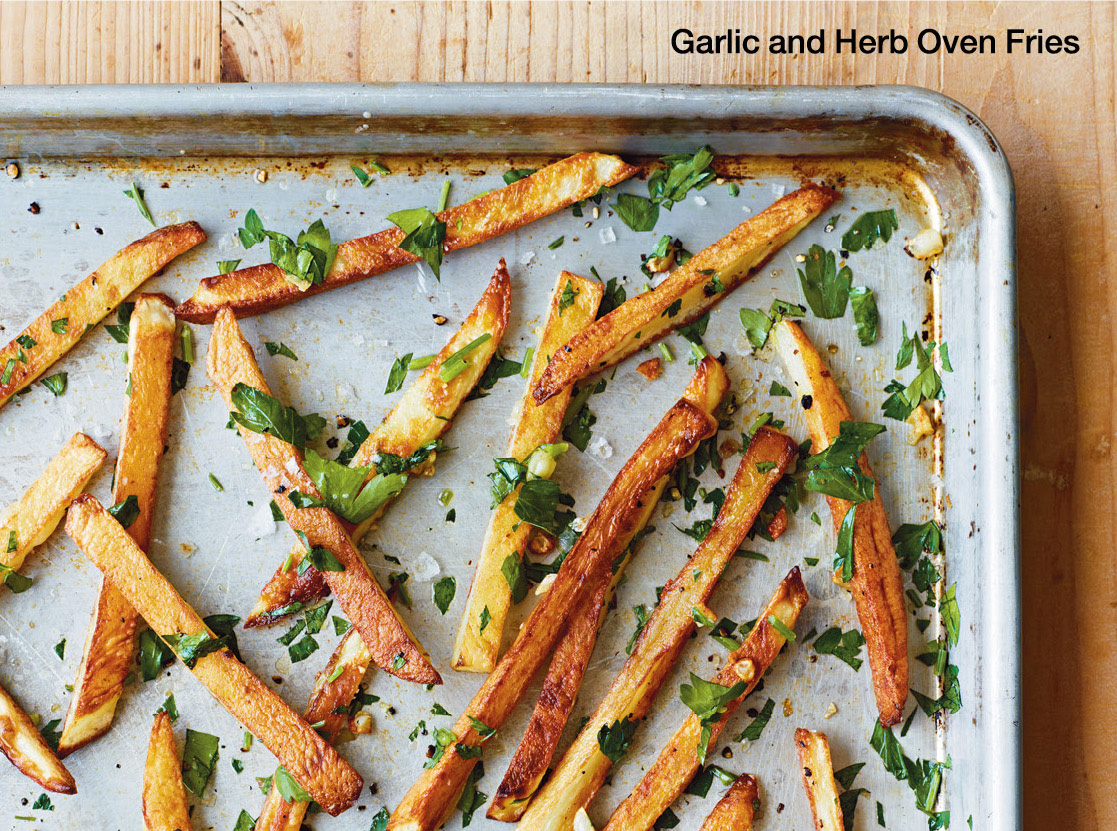
Some think the potato exists purely for French fries. If you’re a fan of all things fried, try this oven-baked version that sizzles in garlicky butter. Russet or other starchy, larger potatoes are best for cutting into matchsticks and keeping good form. Also try the blue varieties Purple Majesty or All Blue, or the all-purpose Kennebec.
2 pounds baking potatoes, peeled
2 tablespoons canola oil
1 1/2 tablespoons butter
1 garlic clove, minced
2 tablespoons chopped fresh parsley
1/2 teaspoon kosher salt
1/4 teaspoon black pepper
1. Place a roasting pan in oven. Preheat oven to 450°.
2. Cut potatoes into 1/4-inch matchsticks; toss with oil. Arrange in preheated pan; bake at 450° for 5 minutes. Turn oven to broil (do not remove pan from oven). Broil 20 minutes or until browned, turning once. Melt butter in a skillet. Add garlic; sauté 30 seconds. Add fries; cook 1 minute. Toss with parsley, salt, and pepper. Serves 6 (serving size: about 1 1/2 cups).
CALORIES 209; FAT 7.7g (sat 2.2g, mono 3.7g, poly 1.5g); PROTEIN 3.1g; CARB 32.9g; FIBER 2.4g; CHOL 8mg; IRON 0.6mg; SODIUM 194mg; CALC 11mg
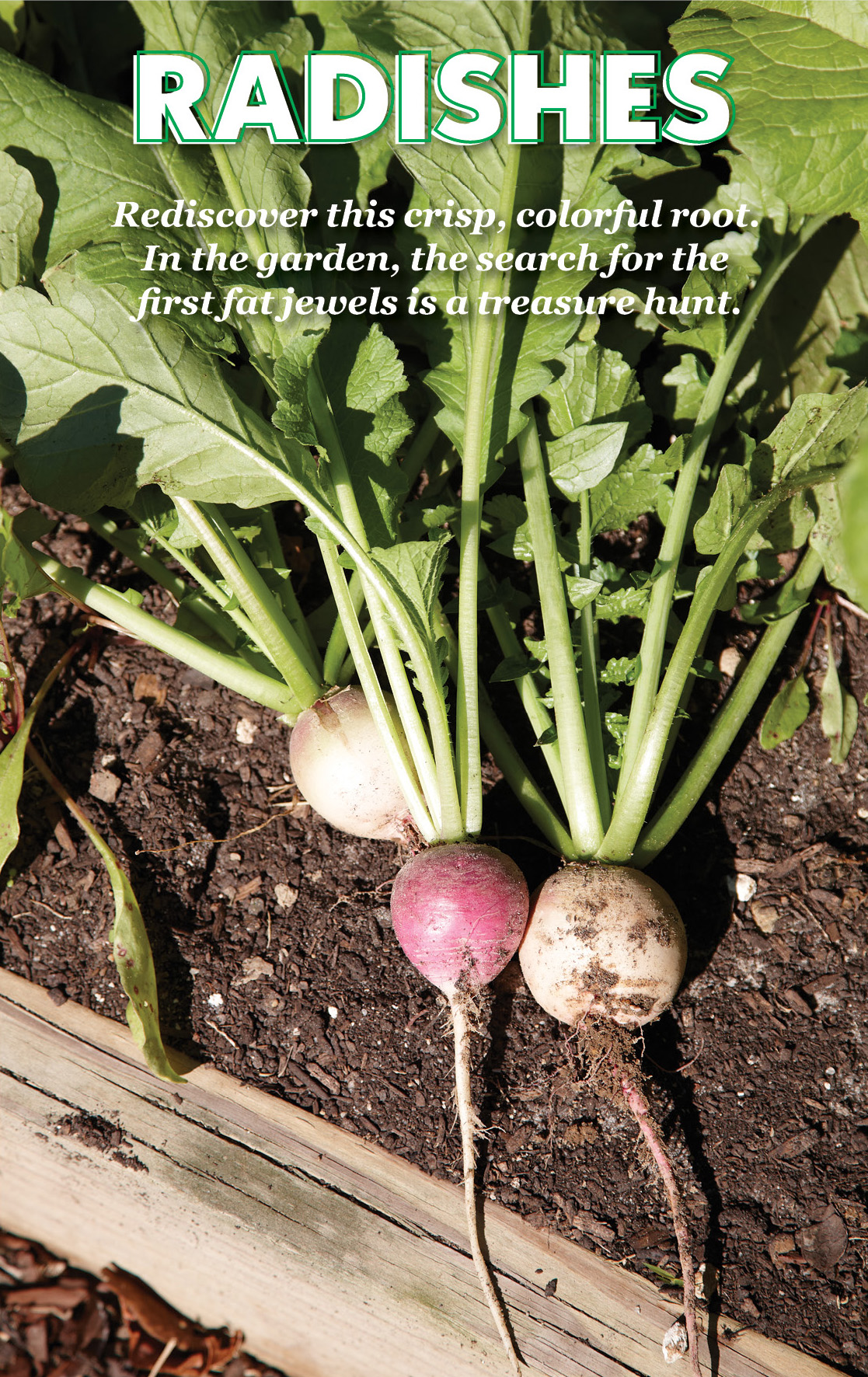
Season: Available year-round in supermarkets, they’re at their peak in spring.
CHOOSING: When purchasing, look for plump, firm roots, preferably with the leaves still attached. Wilted leaves are a sure sign of mealy radishes below.
Storing: When you bring radishes into the kitchen from the market or garden, chop off the greens—if they remain attached, they’ll pull moisture from the crisp root. The greens have a mild, aromatic flavor and can be used raw or cooked. Store the radish roots in a produce bag in your crisper drawer for up to a week. If the radishes become spongy, crisp them by placing them in a bowl of ice water for up to an hour.
Growing: Radishes are the ideal introduction-to-gardening crop. They have a short growing time, ideal for children whose attention spans may not last long enough for some vegetables to mature. The cool months of spring and fall are the ideal times to plant. In the warmest regions of the country, where frost is rare, radishes can be grown all winter, while in the coldest regions they can grow all summer. Young radishes and those that mature in cool weather have a mild flavor. Those harvested in the summer heat have a much sharper, almost biting taste.
Start radish prep as early as your soil can be worked, as much as a month before the last expected freeze. Because many radish varieties require only a month from seed to harvest, you can sow a few seeds every week for a continuous supply. In the fall, begin planting about a month before the first expected frost.
Because plants stay small, growing only 6 to 12 inches tall, they’re a good option to plant between larger, slow-maturing vegetables. For example, spring broccoli transplants need about two months to mature. During the first month, you can raise a crop of radishes. By the time the broccoli grows tall enough to cast shade, the radishes are ready to be pulled and eaten.
Varieties of round, usually red radishes include Early Scarlet Globe, Plum Purple, Pink Beauty, German Giant, and the multicolored Easter Egg II. Long radishes include French Breakfast, White Icicle, and China Rose.
Like all root vegetables, radishes prefer loose, well-drained soil. Drag your trowel lightly to create a 1/2-inch-deep line for planting. Sow seeds about an inch apart, and then smooth the soil over the seeds. Allow 6 inches between rows. Water well and wait, but not for long. Seedlings will emerge in a few days. A helpful tip: Label your radish rows with the date you planted them to help you know when they’re ready to harvest.

Radishes are easy to grow and fast to sow. Add a dotting of seeds to the garden or containers each week for a constant supply that you can slice for salads or stuff into sandwiches like this vegetarian pita. Serve it with another early sign of spring: steamed sugar snap peas.
1 teaspoon grated lemon rind
1 (8-ounce) container plain hummus
4 (6-inch) whole-wheat pitas, halved
4 green leaf lettuce leaves, halved
1 1/4 cups thinly sliced English cucumber
3/4 cup thinly sliced radishes
1/2 cup crumbled feta cheese
1/3 cup thinly sliced red onion
Freshly ground black pepper
1. Combine rind and hummus. Divide hummus mixture evenly among pita halves (about 1 1/2 tablespoons each). Divide lettuce, cucumber, radishes, cheese, and onion evenly among pita halves. Sprinkle with pepper. Serves 4 (serving size: 2 pita halves).
CALORIES 344; FAT 14.9g (sat 2.4g, mono 7.4g, poly 3.6g); PROTEIN 13.1g; CARB 47.1g; FIBER 7.7g; CHOL 13mg; IRON 3.9mg; SODIUM 758mg; CALC 141mg
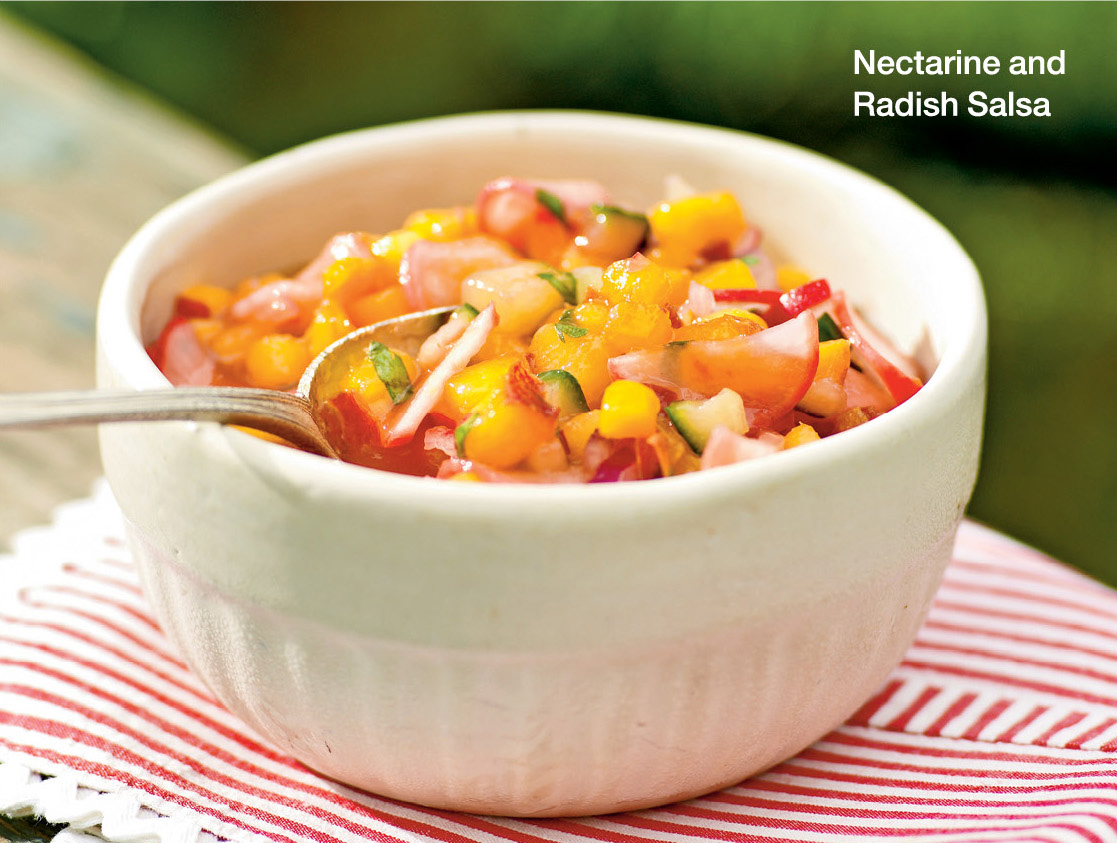
Spicy-sweet and cooling with a citrus tang, this salsa is a refreshing no-cook condiment. Serve with grilled chicken, pork, or fish, or as a dip for toasted tortilla wedges.
2 1/4 cups (1/4-inch) diced nectarines
1 1/2 cups radishes, halved lengthwise and thinly sliced
1/2 cup chopped cucumber
1/4 cup finely chopped red onion
1 tablespoon fresh lime juice
2 teaspoons chopped fresh cilantro
1 1/2 teaspoons sugar
1/4 teaspoon salt
1. Combine all ingredients in a medium bowl; toss well. Let salsa stand 30 minutes. Serves 12 (serving size: 1/3 cup).
CALORIES 18; FAT 0.1g (sat 0g, mono 0g, poly 0.1g); PROTEIN 0.5g; CARB 4.3g; FIBER 0.8g; CHOL 0mg; IRON 0.1mg; SODIUM 55mg; CALC 7mg

Each of these has a bite—whether tart, peppery, or sharp—and blend together well. For consistent texture and great presentation, cut the radish, apple, and radicchio into julienne or matchstick pieces.
3 tablespoons fresh orange juice
3 tablespoons walnut oil
1 tablespoon red wine vinegar
2 teaspoons Dijon mustard
1/4 teaspoon freshly ground black pepper
1/8 teaspoon salt
4 cups thinly sliced radicchio (1 [12-ounce] head)
1 cup thinly sliced radishes (about 6)
2 Granny Smith apples, quartered and cut into julienne strips (about 1 pound)
1/4 cup coarsely chopped walnuts, toasted
1. Combine first 6 ingredients in a large bowl, stirring with a whisk. Add radicchio, radishes, and apples to bowl; toss gently to coat. Place about 3/4 cup salad on each of 8 plates; sprinkle each serving with 1 1/2 teaspoons nuts. Serves 8.
CALORIES 101; FAT 7.7g (sat 0.7g, mono 5g, poly 1.5g); PROTEIN 1.3g; CARB 8.2g; FIBER 1.6g; CHOL 0mg; IRON 0.5mg; SODIUM 82mg; CALC 16mg

Don’t Toss the Top!
The beauty of growing or finding Pink Beauty, Purple Plum, or Watermelon radishes goes beyond the bright Easter egg colors. Young greens pack in vitamin C and are great wilted, sautéed, fresh in salads, or stirred into creamy soups. Try replacing half of the raddicchio in this salad with sliced radish greens.


Season: Although available year-round, spring and fall are the peak seasons.
CHOOSING: Select leaves that are green and smell fresh, with no water-soaked, wilted, or yellowed patches.
Storing: Store spinach in a produce bag in the refrigerator for three to seven days.
Growing: Spinach is a relatively quick crop, needing only five to six weeks from the time seeds are sown until harvest. Select a sunny bed and prepare the soil by working in plenty of compost.
The low-growing spinach lends itself to planting in a bed. (A 2- to 3-foot-wide row that can be worked from one side or the other is ideal.) Level the dirt with a rake, and scatter seeds thinly across the bed. Then rake again to cover the seeds. Water to settle seeds and soil into place. Seedlings will begin to appear in about a week. Thin as needed, and be sure to toss the leaves into your next salad.
Plant spinach seeds in the spring about a month before the last frost. For a fall garden, sow seeds one to two months before the first expected frost. The fall spinach will stop growing once the weather gets cold, but with a little protection from mulch, it will live and provide fresh greens in mild winters and the next spring.
Harvest spinach by pinching off the outer leaves, allowing the plant to remain in the garden to grow. Keeping a layer of mulch around plants will help keep soil from splashing onto the leaves when it rains.
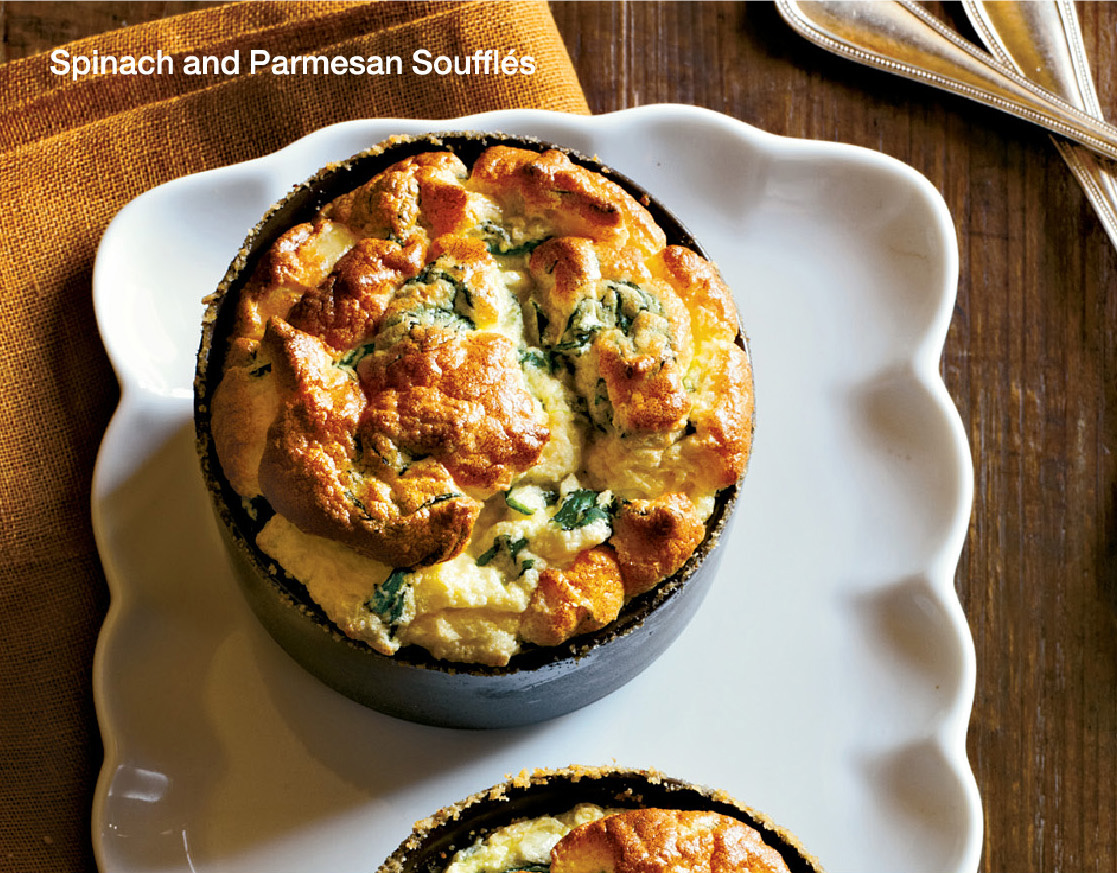
Spinach, eggs, and cheese make a perfect brunch soufflé. As it’s a key ingredient, Italian Parmigiano-Reggiano cheese is worth seeking out. It has a superior nutty flavor you won’t find in the domestic alternatives.
Cooking spray
1 1/2 tablespoons dry breadcrumbs
1 1/2 cups fresh baby spinach
2/3 cup fat-free milk
2 tablespoons all-purpose flour
1/8 teaspoon salt
1/8 teaspoon ground nutmeg
1/8 teaspoon freshly ground black pepper
2 ounces grated fresh Parmigiano-Reggiano cheese (about 1/2 cup)
2 large egg yolks
4 large egg whites
1/4 teaspoon cream of tartar
1. Place a baking sheet in oven. Preheat oven to 425°.
2. Coat 4 (6-ounce) ramekins with cooking spray, and sprinkle evenly with breadcrumbs, tilting and turning dishes to coat sides completely.
3. Heat a large skillet over medium-high heat. Coat pan with cooking spray. Add spinach; cook 2 minutes or until spinach wilts, tossing constantly. Place spinach in a colander; let stand 5 minutes. Squeeze excess liquid from spinach. Coarsely chop.
4. Combine milk and next 4 ingredients (through black pepper) in a small saucepan over medium-high heat, stirring with a whisk until smooth. Cook 2 minutes or until mixture is thick and bubbly, stirring constantly. Spoon mixture into a large bowl, and let stand 10 minutes. Stir in spinach, cheese, and egg yolks.
5. Combine egg whites and cream of tartar in a large bowl, and let stand at room temperature 15 minutes. Beat with a mixer at high speed until medium peaks form (do not overbeat). Gently stir one-fourth of egg whites into spinach mixture, and gently fold in remaining egg whites. Gently spoon mixture into prepared dishes. Sharply tap dishes 2 or 3 times on counter to level. Place dishes on preheated baking sheet; return baking sheet to 425° oven. Immediately reduce oven temperature to 350°; bake soufflés at 350° for 21 minutes or until puffy and golden brown. Serve immediately. Serves 4 (serving size: 1 soufflé).
CALORIES 163; FAT 6g (sat 2.8g, mono 1.9g, poly 0.6g); PROTEIN 13.2g; CARB 14.6g; FIBER 1.4g; CHOL 115mg; IRON 1.7mg; SODIUM 405mg; CALC 218mg
Creamed spinach is a quintessential, but fat-packed steak house side. Try this lightened classic with cremini mushrooms and nutmeg. Since the spinach is lightly wilted and tossed with the sauce, this recipe would showcase colorful varieties such as Bordeaux or Cardinal with deep red stems.
4 teaspoons canola oil, divided
8 ounces sliced cremini mushrooms
2 1/2 cups fresh baby spinach
1/3 cup finely chopped shallots
2 teaspoons minced fresh garlic
3/4 cup fat-free milk
1 tablespoon all-purpose flour
3/8 teaspoon salt
1/4 teaspoon black pepper
Dash of nutmeg
2 1/2 ounces 1/3-less-fat cream cheese (about 1/3 cup)
1. Heat a skillet over medium-high heat. Add 1 1/2 teaspoons oil; swirl to coat. Add mushrooms; cook 6 minutes or until liquid evaporates. Remove from pan. Add 1 1/2 teaspoons oil; swirl to coat. Add spinach; cook 1 minute or until wilted. Remove from heat.
2. Heat a Dutch oven over medium heat. Add 1 teaspoon oil to pan; swirl to coat. Add shallots and garlic; cook 1 minute, stirring constantly. Combine milk and flour in a bowl, stirring with a whisk. Add milk mixture, salt, pepper, and nutmeg to pan; bring to a boil, stirring constantly. Cook 3 minutes or until thick, stirring constantly. Add cheese; stir until cheese melts and mixture is smooth. Add mushrooms and spinach to milk mixture; toss gently to coat. Serves 6 (serving size: 1/2 cup).
CALORIES 102; FAT 6.1g (sat 1.8g, mono 2.7g, poly 1.1g); PROTEIN 4.8g; CARB 8.1g; FIBER 1.4g; CHOL 9mg; IRON 1.7mg; SODIUM 241mg; CALC 111mg
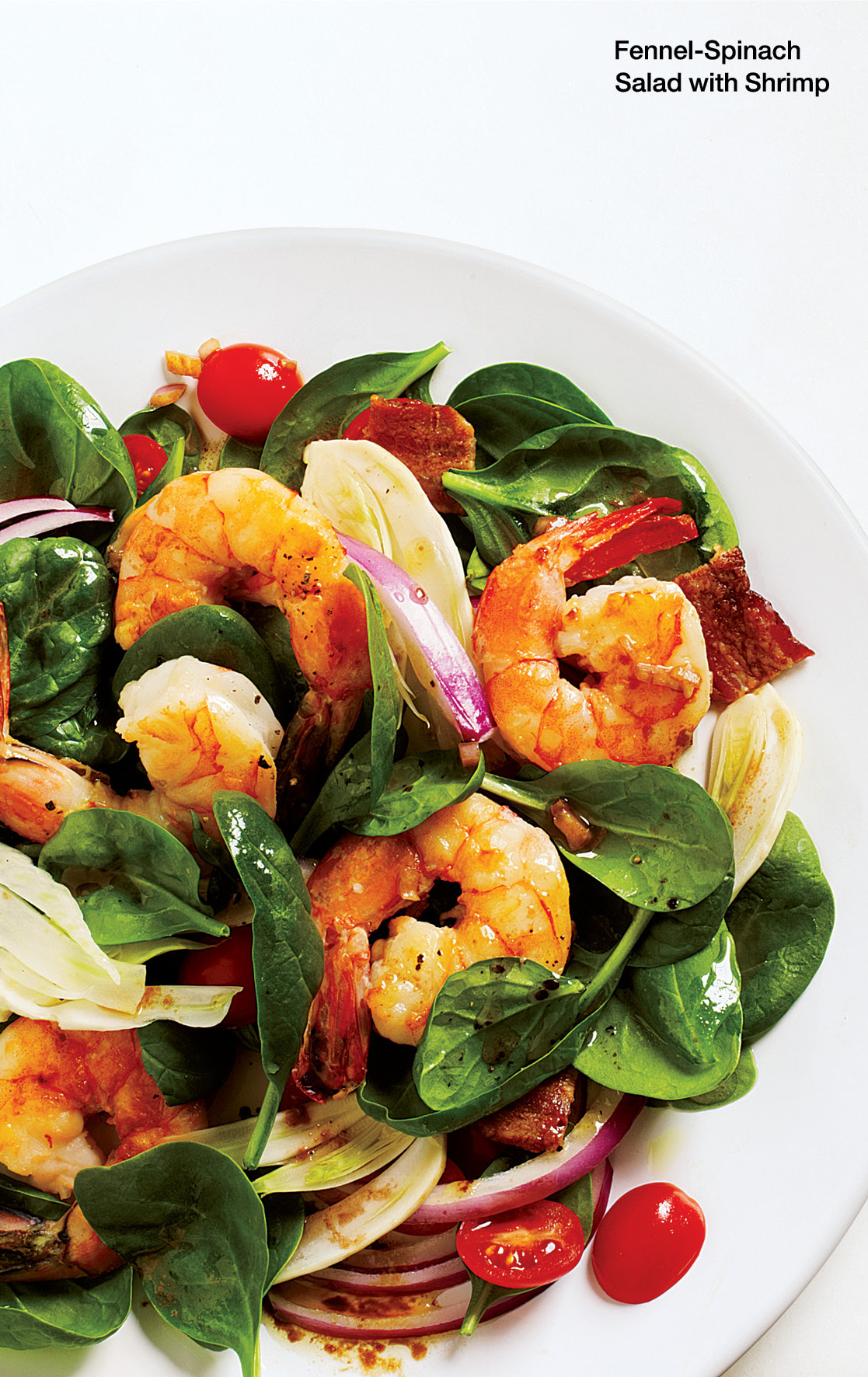
Quick, fresh, light—the perfect trifecta for a weeknight meal. Thin slices of fennel with fresh spinach leaves are nice bites that contrast with bacon and bacon-sautéed shrimp. It’s fast and looks fancy.
3 center-cut bacon slices
1 pound jumbo shrimp, peeled and deveined
2 1/4 cups fresh baby spinach
2 cups thinly sliced fennel bulb
1 cup grape tomatoes, halved
1/2 cup thinly sliced red onion
3 tablespoons extra-virgin olive oil
2 tablespoons finely chopped shallots
1 tablespoon balsamic vinegar
1 teaspoon Dijon mustard
1/4 teaspoon salt
1/4 teaspoon black pepper
1. Cook bacon in a skillet over medium heat until crisp. Remove bacon from pan, reserving drippings; crumble. Add shrimp to pan; cook 2 minutes, turning once.
2. Combine bacon, spinach, fennel, tomatoes, and onion in a bowl. Combine oil and remaining ingredients in a small bowl, stirring with a whisk. Add shrimp and balsamic mixture to spinach mixture; toss well. Serves 4 (serving size: about 3 1/2 cups).
CALORIES 274; FAT 13.5g (sat 2.2g, mono 7.7g, poly 1.9g); PROTEIN 27.5g; CARB 11.2g; FIBER 3.5g; CHOL 176mg; IRON 5mg; SODIUM 487mg; CALC 156mg

Season: Summer
Choosing: Look for smooth, blemish-free squashes. A small, tender squash is preferable to an oversized, seedy one.
Storing: Place squash in a produce bag in the vegetable bin of the refrigerator for up to a week.
Growing: The basic summer squashes are yellow (crookneck or straightneck), zucchini (green or yellow, long or round), and pattypan (scallop). The plants are similar, growing like a large shrub with fuzzy leaves that make your arms itch.
Squash needs a sunny spot and is grown from seeds sown in hills—a small mound made by digging a hole and filling it full of good compost mixed with the existing soil. Plant about five seeds in the resulting 1-foot-wide, slightly raised bed. Space the hills about 3 to 5 feet apart, depending on the size of the plants you’re growing.
Immediately after the danger of frost has passed, push seeds about an inch deep into each hill, water, and wait about a week. If needed, thin each hill to contain only two plants, one on each side of the hill.
If your plant is covered in blooms but you see no squash, never fear. The first blooms are male; the female flowers (those with tiny fruits at the base of the bloom) will begin appearing shortly thereafter. Harvest these edible male squash blossoms early in the morning, when they are fully open, for a homegrown delicacy stuffed and sautéed—just leave enough male and female blooms to create future fruits.
If summer squashes are left on the plant, they grow quite large, developing a hard rind and big seeds. However, these big guys lack the culinary appeal of smaller, tender squashes; remove them from the plant, and place them on the compost pile. Plant again about a month after the first sowing if you have room for a second crop.

When you are looking for ways to use up all those squash that seem to appear overnight, this will set you back at least 4 cups. Great for dinner or brunch, this quiche also introduces a crust that you can use for other homemade pies.
6.75 ounces all-purpose flour (about 1 1/2 cups)
1/2 teaspoon salt
3 tablespoons chilled unsalted butter, cut into small pieces
2 tablespoons vegetable shortening, cut into small pieces
1/4 cup ice water
Cooking spray
1 tablespoon extra-virgin olive oil
2 cups (1/8-inch-thick) slices yellow squash
2 cups (1/8-inch-thick) slices zucchini
1/4 cup chopped shallots
1 tablespoon chopped fresh thyme
1 cup 2% reduced-fat milk
3/4 teaspoon salt
1/4 teaspoon black pepper
4 center-cut bacon slices, cooked and crumbled
3 large egg whites
3 large eggs
3 ounces shredded part-skim mozzarella cheese (about 3/4 cup)
1. Weigh or lightly spoon flour into dry measuring cups; level with a knife. Place flour and 1/2 teaspoon salt in a food processor; pulse 2 times or until combined. Add butter and shortening; pulse 4 times or until mixture resembles coarse meal. With food processor on, add 1/4 cup ice water through food chute, processing just until mixture is combined (do not form a ball). Press mixture into a 4-inch circle on plastic wrap, and cover. Refrigerate 1 hour.
2. Preheat oven to 400°.
3. Slightly overlap 2 sheets of plastic wrap on a slightly damp, flat surface. Unwrap and place dough on plastic wrap. Cover dough with 2 additional sheets of overlapping plastic wrap. Roll dough, still covered, into a 12-inch circle. Freeze dough 5 minutes or until plastic wrap can be easily removed. Remove top sheets of plastic wrap, and fit dough, plastic wrap side up, into a 9 1/2-inch deep-dish pie plate coated with cooking spray. Remove remaining plastic wrap. Fold edges under; flute. Pierce bottom and sides of dough with fork. Bake at 400° for 15 minutes. Cool on a wire rack.
4. Reduce oven temperature to 350°.
5. Heat a nonstick skillet over medium-high heat. Add oil to pan; swirl to coat. Add squash, zucchini, shallots, and thyme; sauté 5 minutes or until tender. Cool slightly.
6. Combine milk and next 5 ingredients in a bowl. Arrange squash mixture evenly over crust; sprinkle with cheese. Pour egg mixture over cheese. Bake at 350° for 45 minutes or until filling is set. Cool 15 minutes on a wire rack. Serves 8.
CALORIES 265; FAT 14.1g (sat 6.3g, mono 4.3g, poly 1.5g); PROTEIN 11.2g; CARB 22.4g; FIBER 1.2g; CHOL 90mg; IRON 1.7mg; SODIUM 556mg; CALC 134mg
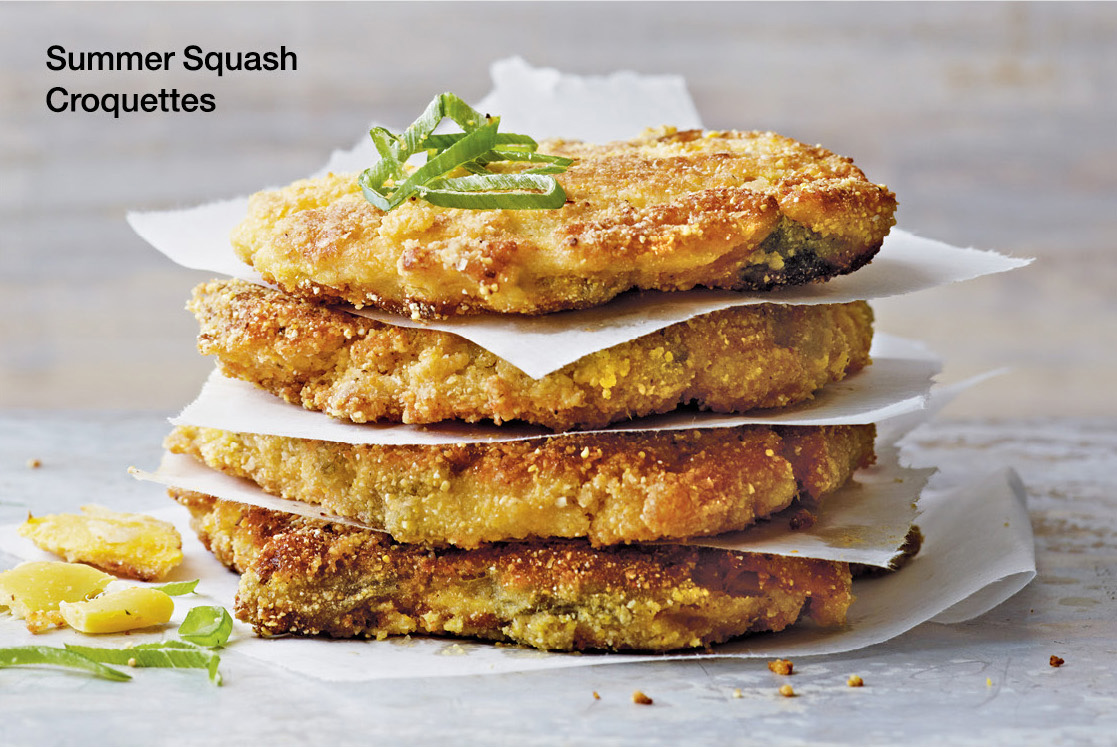
A healthier version of a family dinner classic, these pan-fried croquettes will get the kids to eat squash. Make sure to drain the steamed squash well for cohesive patties.
4 2/3 cups coarsely chopped yellow squash (about 1 1/4 pounds)
1/2 cup chopped green onions
1 cup crushed saltine crackers (about 30 crackers)
1/2 teaspoon sugar
1/8 teaspoon salt
2 large eggs
1/4 cup yellow cornmeal
Cooking spray
1 tablespoon canola oil, divided
Sliced green onions (optional)
1. Steam squash and 1/2 cup onions, covered, 15 minutes or until tender. Drain well. Mash mixture with a fork. Stir in crackers and next 3 ingredients (through eggs). Cover and chill 3 hours; drain well in a fine sieve.
2. Place cornmeal in a shallow dish. Divide squash mixture into 12 equal portions, shaping each portion into a 1/2-inch-thick patty. Dredge patties in cornmeal. Lightly coat each patty with cooking spray.
3. Heat a large nonstick skillet over medium-high heat. Add 1 teaspoon canola oil to pan; swirl to coat. Place 4 patties in pan; cook 1 1/2 minutes on each side or until golden. Remove patties from pan. Repeat procedure 2 times with 2 teaspoons oil and 8 patties. Garnish with sliced green onions, if desired. Serve immediately. Serves 6 (serving size: 2 patties).
CALORIES 151; FAT 6.3g (sat 1g, mono 3.1g, poly 1.4g); PROTEIN 6.6g; CARB 18.6g; FIBER 2.1g; CHOL 71mg; IRON 2.2mg; SODIUM 245mg; CALC 45mg

If you celebrate national “Sneak Some Zucchini Onto Your Neighbors’ Porch Day,” at least leave them some in loaves of chocolate! This is a moist, decadent version that is also great for the freezer.
3/4 cup sugar
3 tablespoons canola oil
2 large eggs
1 cup applesauce
9 ounces all-purpose flour (about 2 cups)
2 tablespoons unsweetened cocoa
1 1/4 teaspoons baking soda
1 teaspoon ground cinnamon
1/4 teaspoon salt
1 1/2 cups finely shredded zucchini (about 1 medium)
1/2 cup semisweet chocolate chips
Cooking spray
1. Preheat oven to 350°.
2. Place first 3 ingredients in a large bowl; beat with a mixer at low speed until well blended. Stir in applesauce.
3. Weigh or lightly spoon flour into dry measuring cups; level with a knife. Combine flour and next 4 ingredients (through salt), stirring well with a whisk. Add flour mixture to sugar mixture, beating just until moist. Stir in zucchini and chocolate chips. Spoon batter into a 9 x 5–inch loaf pan coated with cooking spray. Bake at 350° for 1 hour or until a wooden pick inserted in center comes out almost clean. Cool in pan 10 minutes on a wire rack, and remove from pan. Cool completely on wire rack. Serves 16 (serving size: 1 slice).
CALORIES 161; FAT 5.1g (sat 1.6g, mono 1.4g, poly 1.7g); PROTEIN 2.9g; CARB 27.3g; FIBER 1.4g; CHOL 27mg; IRON 1.2mg; SODIUM 145mg; CALC 12mg

Get Pickled
When you’re weary of sautéing it, stuffing it, baking it into bread, and unloading it on neighbors, make zucchini pickles. They’re every bit as delicious as their cucumber counterparts. Follow your favorite recipe, or give this sweet-spicy version a go: Combine 4 cups (1/8-inch-thick) slices zucchini, 1 cup slivered sweet onion, and 3 thinly sliced garlic cloves in a glass bowl. Bring 1 cup white vinegar, 1/2 cup sugar, 3/4 teaspoon crushed red pepper, 1 teaspoon mustard seeds, and 3/4 teaspoon kosher salt to a boil; pour over zucchini mixture. Cover and chill 24 hours. Serves 16.
CALORIES 9; FAT 0.1 (sat 0g); SODIUM 32mg


Season: Although sweet potatoes store well and are available most of the year, fall is when the fresh crop comes in.
CHOOSING: Select sweet potatoes that are firm and free of injuries.
Storing: The ideal temperature for storing sweet potatoes is in the 50s—warmer than the refrigerator and cooler than room temperature. An unheated garage or basement or a cool, dark cabinet or pantry is ideal. If stored properly, they’ll last three to six months. Otherwise, only buy as many as you can eat in a week or two.
Growing: Sweet potatoes love hot weather and despise the cold, so wait to plant them until after the soil has warmed in spring, about three weeks after the last frost. They need 100 to 120 days to grow, depending on the variety, so get them started as early as possible.
Opt for varieties from disease-free sources. This may require you to order plants, known as slips, by mail. Create a raised, compost-enriched bed that is about a foot tall, 2 to 3 feet wide, and as long as you like in a sunny spot. Space plants about a foot apart, staggering them in the bed. Keep the soil moist until the new plants begin growing. Then water anytime the plants may be under stress from too little rain. Be sure to note the date you planted and how many days your plants need to mature.
Once the recommended number of days has passed, dig up a potato. If it’s about the size you want, go ahead and harvest the rest. Leaving them in the ground longer will result in larger sweet potatoes, but they can grow so large that they are unusable. If temperatures below 40° are forecast before your sweet potatoes are scheduled to be harvested, go ahead and dig them up; cold weather can ruin the roots.
Because sweet potatoes aren’t very sweet or moist when first harvested, you’ll need to cure them for about eight weeks. This period of warmth and humidity helps heal any cuts and triggers the development of the sugar-creating enzymes that give these veggies their distinct flavor. Store them at 70° to 85°—the ideal location in your home may be near the water heater or on top of the refrigerator or clothes dryer—for 5 to 10 days. Then store them in the 50° range for six to eight weeks, which helps the sugars develop further.

Sweet with heat! The natural sweetness of the potatoes pairs well with a bit of spice from chipotle peppers and Mexican chorizo. There’s a fair amount of heat in the recipe, so if you prefer milder food, use less chipotle. A dash of green onions and cilantro tops off this fresh take on mac and cheese. Serve with a green salad to offset what seems deliciously gluttonous.
3 medium-sized sweet potatoes (about 2 pounds)
1 cup fat-free milk
1 1/2 to 2 tablespoons chopped chipotle chile, canned in adobo sauce
3/8 teaspoon kosher salt
1/4 teaspoon freshly ground black pepper
3 ounces Monterey Jack cheese, shredded (about 3/4 cup)
8 ounces uncooked whole-wheat penne or macaroni pasta
1 tablespoon olive oil
6 ounces fresh Mexican chorizo, casings removed
1/4 cup chopped green onions
2 tablespoons chopped fresh cilantro
1. Preheat oven to 425°.
2. Pierce potatoes several times with a fork; place on a foil-lined baking sheet. Bake at 425° for 1 hour or until tender. Cool slightly; peel and mash in a large bowl. Stir in milk and next 4 ingredients (through cheese).
3. Cook pasta according to package directions, omitting salt and fat; drain. Add pasta to sweet potato mixture; set aside.
4. Preheat broiler.
5. Heat a large ovenproof skillet over medium heat. Add oil to pan; swirl to coat. Add chorizo to pan; cook 4 minutes or until browned, stirring to crumble. Place chorizo in a small bowl. Wipe pan clean. Spoon sweet potato mixture into pan; sprinkle evenly with chorizo. Broil 2 minutes or until lightly browned and crisp. Sprinkle with onions and cilantro. Serves 6 (serving size: about 1 cup).
CALORIES 456; FAT 15.5g (sat 6.2g, mono 6.9g, poly 1.4g); PROTEIN 18.6g; CARB 63.2g; FIBER 8.8g; CHOL 32mg; IRON 3.1mg; SODIUM 589mg; CALC 235mg

Sweet potatoes are a good source of vitamins A and C and offer a healthy dose of fiber—3.8 grams in one medium potato. They are more nutritious if cooked in their skins because more of the water-soluble vitamins are retained.


A clear favorite in taste-testing, this salad is a spicy-sweet-savory mix of bold flavors. Be sure to let the cranberries cook until they start to pop; the juice helps to thicken the dressing. Don’t skip the pepitas! Use your own roasted, salted pumpkinseeds when in season for a crunchy bite.
2 1/2 pounds sweet potatoes, peeled and cut into 2-inch pieces
3 tablespoons olive oil, divided
3/4 teaspoon kosher salt
1/2 teaspoon freshly ground black pepper
3/4 cup fresh or frozen cranberries
1/4 cup water
2 teaspoons honey
1 (7-ounce) can chipotle chiles in adobo sauce
1/2 cup pepitas (pumpkin seeds)
3/4 cup chopped green onions
1/4 cup fresh cilantro leaves
1. Preheat oven to 450°.
2. Place sweet potatoes on a large jelly-roll pan. Drizzle with 2 tablespoons oil, and sprinkle with salt and pepper; toss to coat. Bake at 450° for 30 minutes or until tender, turning after 15 minutes.
3. Place 1 tablespoon oil, cranberries, 1/4 cup water, and honey in a saucepan. Remove 1 or 2 chiles from can; finely chop to equal 1 tablespoon. Add chopped chiles and 1 teaspoon adobo sauce to pan (reserve remaining chiles and sauce for another use). Place pan over medium-low heat; bring to a boil. Cover, reduce heat, and cook 10 minutes or until cranberries pop, stirring occasionally. Remove from heat. Mash with a potato masher or fork until chunky.
4. Place pepitas in a medium skillet; cook over medium heat 4 minutes or until lightly browned, shaking pan frequently.
5. Combine potatoes, pepitas, onions, and cilantro in a bowl. Add cranberry mixture to bowl; toss gently to coat. Serves 8 (serving size: 3/4 cup).
CALORIES 189; FAT 8.4g (sat 1.3g, mono 5.5g, poly 0.9g); PROTEIN 3.7g; CARB 25.5g; FIBER 4.5g; CHOL 0mg; IRON 1.3mg; SODIUM 335mg; CALC 40mg

Growing your own sweet potatoes is easy. And the reward is tenfold—in pounds and fun—as uncovering these in early fall is better than hunting Easter eggs. Mashing them with browned butter and topping with crunchy pecans makes a simple holiday staple. For a kid-friendly showstopper, try one of the purple varieties (you may need a little more liquid, as they tend to be starchier).
4 sweet potatoes (about 2 pounds)
1 1/2 tablespoons butter
2 tablespoons fat-free milk
1/4 teaspoon salt
1/4 cup chopped pecans, toasted
1. Pierce each potato with a fork 3 to 4 times on each side. Wrap each potato in a damp paper towel. Microwave at HIGH 8 minutes, turning after 4 minutes. Cool slightly. Cut potatoes in half; scoop pulp into a bowl. Mash pulp.
2. Heat butter in a small saucepan over medium heat; cook 3 minutes or until browned. Stir butter, milk, and salt into potato pulp. Top with pecans. Serves 4 (serving size: 1⁄2 cup).
CALORIES 262; FAT 9.2g (sat 3.2g, mono 3.9g, poly 1.6g); PROTEIN 4.4g; CARB 41.5g; FIBER 7.6g; CHOL 12mg; IRON 1.4mg; SODIUM 304mg; CALC 51mg

Season: May through September in the most temperate regions; June through August is peak season nationwide.
CHOOSING: Look for tomatoes with a bright, shiny skin and firm flesh that yields slightly to gentle pressure. The best flavor comes from vine-ripened fruits that were recently picked, so opt for those marked “locally grown.”
Storing: Store them at room temperature but not in direct sunlight—the kitchen windowsill may not be the best spot. Never store tomatoes in the refrigerator. The cold destroys flavor and leaves tomatoes with a mealy texture. It’s best to use tomatoes within four or five days of picking or purchasing.
Growing: There are hundreds of varieties, with one to suit every gardener’s space and taste. For containers, consider a variety that keeps a compact shape, such as Husky Cherry Red or Better Boy Bush. Cherry tomatoes are usually indeterminate, meaning they continually vine and grow on a trellis or balcony railing. Consider growing one of each of these three types: a “slicer,” such as Cherokee Purple, for big, meaty fruits; a “paste” tomato, such as Roma, San Marzano, or Black Plum, for making sauces; and a cherry, such as Sun Gold, for eat-as-you-pick bites of sunshine.
Tomatoes need full sun and flourish with several gallons of water a week. When growing in containers, ensure the pots are at least 24 inches in diameter. Deep roots are the secret to keeping plants well watered and healthy. Contrary to how you normally plant, bury a tomato transplant up to its “neck,” with only three or four leaves above the soil—roots will form along the stem beneath the ground to produce a stronger, sturdier plant.

Keep it simple with “summer on a plate.” Prized tomatoes barely make it to the stovetop in the peak of summer, so stun guests with a rainbow stack of sliced tomatoes. This one is certainly a conversation starter and the best way to brag on your garden or farmers’ market finds. For the prettiest presentation and a unique mix of flavors, choose purple, orange, green, red, or yellow tomatoes. Green Zebra, Black Krim, and Dr. Wyche’s Yellow are favorites.
2 bacon slices, halved
1/4 cup low-fat buttermilk
1 tablespoon finely chopped fresh chives
1 tablespoon finely chopped fresh basil
2 tablespoons canola mayonnaise
2 teaspoons cider vinegar
1 garlic clove, minced
1/2 teaspoon freshly ground black pepper, divided
2 ears shucked corn
Cooking spray
2 large beefsteak tomatoes, cut into 8 (1/2-inch-thick) slices total
2 globe tomatoes, cut into 8 (1/2-inch-thick) slices total
1/8 teaspoon kosher salt
1/2 ripe peeled avocado, thinly sliced
4 teaspoons extra-virgin olive oil
1. Preheat grill to high heat.
2. Heat a large nonstick skillet over medium heat. Add bacon to pan; cook 8 minutes or until crisp, tossing occasionally to curl. Drain bacon on paper towels.
3. Combine buttermilk and next 5 ingredients (through garlic), stirring with a whisk. Stir in 1/4 teaspoon pepper.
4. Coat corn with cooking spray. Place corn on grill rack; grill 8 minutes or until well marked, turning occasionally. Remove from grill; cool slightly. Cut corn kernels from cobs.
5. Sprinkle tomato slices evenly with salt. Alternate layers of tomato and avocado on each of 4 plates. Scatter corn evenly onto plates. Drizzle each tomato stack with about 1 1/2 tablespoons dressing and 1 teaspoon oil. Sprinkle 1/4 teaspoon pepper evenly over salads; top each salad with 1 bacon piece. Serves 4.
CALORIES 191; FAT 13g (sat 1.9g, mono 8g, poly 2.2g); PROTEIN 5.1g; CARB 16.1g; FIBER 4.5g; CHOL 5mg; IRON 0.9mg; SODIUM 228mg; CALC 40mg

Tomatoes are a treasure trove of good-for-you plant compounds, including vitamins C and E, beta-carotene, and lycopene, a disease-fighting antioxidant that gives some varieties their brilliant red hue. High lycopene intake has been linked to lower risk for cardiovascular disease.


Don’t doubt this sauce because it’s so easy. The key is your sun-ripened garden tomato. San Marzano, Roma, or the smaller, dark-shouldered Black Plum would be ideal. Use the sauce on fresh, artisanal pastas for a truly special meal.
1 1/2 pounds plum tomatoes, peeled and halved lengthwise
3 tablespoons extra-virgin olive oil, divided
2 garlic cloves, minced
2 tablespoons plus 1⁄2 teaspoon fine sea salt, divided
1/4 teaspoon crushed red pepper
6 quarts water
12 ounces uncooked spaghetti
1/4 cup basil leaves
6 tablespoons grated fresh Parmigiano-Reggiano cheese
1. Squeeze juice and seeds from tomato halves into a fine sieve over a bowl, reserving juices; discard seeds. Finely chop tomatoes.
2. Heat 2 tablespoons oil in a large nonstick skillet over medium heat. Add garlic to pan; cook 30 seconds or just until garlic begins to brown, stirring constantly. Add tomatoes, reserved juices, 1/2 teaspoon salt, and pepper. Increase heat to medium-high, and cook 15 minutes or until liquid almost evaporates, stirring occasionally.
3. Bring 6 quarts water and 2 tablespoons salt to a boil in an 8-quart pot. Add pasta to pot; stir. Cover; return to a boil. Uncover and cook 8 minutes or until pasta is almost al dente. Drain pasta in a colander over a bowl, reserving 1/2 cup cooking liquid.
4. Add hot pasta and reserved 1/2 cup cooking liquid to tomato mixture. Cook 5 minutes or until sauce is thick and pasta is al dente, tossing to combine. Remove from heat. Sprinkle with basil; toss. Place 1 cup pasta mixture on each of 6 plates. Drizzle each serving with 1/2 teaspoon of oil; sprinkle each with 1 tablespoon cheese. Serves 6.
CALORIES 313; FAT 9.5g (sat 2.1g, mono 5.6g, poly 1.5g); PROTEIN 10.3g; CARB 47g; FIBER 3.2g; CHOL 4mg; IRON 2.3mg; SODIUM 576mg; CALC 83mg

How to Peel Tomatoes Easily
Peeling tomatoes is an important first step when making tomato sauce—you want to avoid curled skins speckling your sauce. To avoid spending hours in the kitchen peeling the tomatoes by hand, follow these steps:
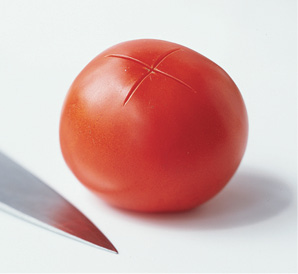
1. Bring a pot of water to a boil. While you’re waiting for the water to boil, cut a 1-inch X in the bottom of each tomato. Place the tomatoes in the boiling water, and cook for 30 seconds to 1 minute.
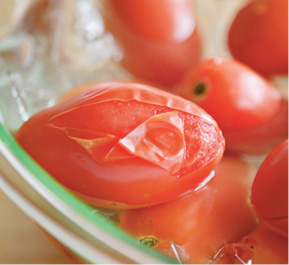
2. Quickly remove each tomato with a slotted spoon, and drop it into a bowl of ice water for 1 minute to stop the cooking process.
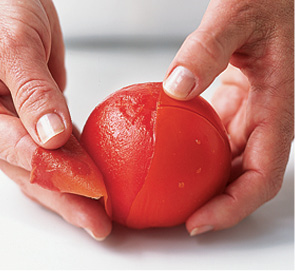
3. Remove the tomatoes from the water, and peel back the flaps from the X; the skin will be easy to remove.


Highlight two champions of summer: wild arctic char and pints of sunny sweet cherry tomatoes. Wild arctic char from the northern seas is available for only a few weeks in late summer, when the ice has melted enough for the local fishermen to reach them. It is a sought-after delicacy, and one that will cost you. Fresh is well worth the splurge when you can find it. Farmed char is a smart, sustainable option, or substitute fresh wild salmon. Sun Gold, Green Grape, Black Cherry, and Gold Nugget tomatoes are perfect choices to grow for this recipe.
3 tablespoons extra-virgin olive oil, divided
4 (6-ounce) arctic char fillets
3/4 teaspoon coarse salt, divided
1/2 teaspoon black pepper, divided
4 garlic cloves, halved
3 pints multicolored cherry tomatoes
1/4 cup thinly sliced fresh basil
2 shallots, thinly sliced
1. Preheat oven to 400°.
2. Heat a large ovenproof skillet over high heat. Add 1 tablespoon oil to pan; swirl to coat. Sprinkle fillets with 1/2 teaspoon salt and 1/4 teaspoon pepper. Add fillets, flesh sides down, to pan, and sauté 2 minutes. Place pan in oven; bake at 400° for 3 minutes or until desired degree of doneness.
3. Heat a large cast-iron skillet over medium heat. Add 2 tablespoons oil to pan; swirl to coat. Add garlic, and cook 2 minutes or until lightly browned, stirring occasionally. Increase heat to medium-high. Add tomatoes to pan; sauté 2 minutes or until skins blister, stirring frequently. Remove pan from heat. Sprinkle tomato mixture with 1/4 teaspoon salt, 1/4 teaspoon pepper, basil, and shallots; toss to combine. Serve with fish. Serves 4 (serving size: 1 fillet and about 3/4 cup tomato mixture).
CALORIES 380; FAT 20.4g (sat 3.8g, mono 11.7g, poly 3.6g); PROTEIN 31.4g; CARB 20g; FIBER 2.9g; CHOL 65mg; IRON 2mg; SODIUM 514mg; CALC 49mg

Season: Summer and fall are harvest times for winter squash, but they store so well that they’re available almost year-round.
CHOOSING: Winter squash should have a hard rind and feel heavy. The stem and rind should be undamaged.
Storing: The ideal storage place would be one that is not as cold as a refrigerator, but not as warm as a heated house. A cool pantry or cabinet or an unheated garage or basement that stays in the 50s is ideal.
Growing: Although you grow them at the same time as summer squash, winter squash is named because of its harder skin that makes it capable of long winter storage. The vigorous vines do best planted in full sun on hills—small mounds in the garden where a hole has been dug and then backfilled with a mixture of compost and the existing soil. Space the hills about 8 feet apart; the vines need room to ramble.
After all danger of frost has passed in spring, push about five seeds into each hill, water well, and after a week or two, thin the seedlings to two plants. Since the vines will cover a lot of ground, cover the bed with mulch to keep down weeds while protecting the developing fruits from rot. It takes about 80 to 100 days for them to be ready for harvest. You’ll know they’re ready when the rind is so hard that you can’t puncture it with your thumbnail. Depending on the length of your growing season, you may want to eat the first batch of squash and plant a second round for storing over the winter.

This is a hearty side that can work as a main entrée or as a vegetarian dish, if you omit the pancetta and substitute vegetable broth.
1/2 cup coarsely chopped walnuts
1 tablespoon butter, melted
1 teaspoon brown sugar
1/8 teaspoon freshly ground black pepper
2 cups (1/2-inch) cubed peeled butternut squash
1 tablespoon olive oil
2 teaspoons minced fresh garlic
4 cups fat-free, lower-sodium chicken broth
1/2 cup water
1 ounce pancetta, finely chopped (about 1/4 cup)
1 cup finely chopped onion
1 1/4 cups uncooked Arborio rice
1/2 cup chardonnay
2 tablespoons finely chopped fresh lemon thyme or 1 1/2 tablespoons thyme plus 1/2 teaspoon grated lemon rind
1/4 teaspoon salt
1/4 teaspoon freshly ground black pepper
1 ounce shaved fresh Parmigiano-Reggiano cheese (about 1/4 cup)
1. Preheat oven to 400°.
2. Arrange nuts in a single layer on a jelly-roll pan. Bake at 400° for 5 minutes or until toasted, stirring twice. Place nuts in a bowl. Drizzle butter over warm nuts; sprinkle with sugar and 1/8 teaspoon pepper. Toss well to coat.
3. Combine squash and 1 tablespoon oil, tossing to coat. Arrange squash in a single layer on jelly-roll pan. Bake at 400° for 15 minutes or until squash is just tender. Remove from pan; stir in garlic. Set aside.
4. Bring broth and 1/2 cup water to a simmer in a saucepan (do not boil). Keep warm over low heat.
5. Heat a large saucepan over medium heat. Add pancetta to saucepan; cook 5 minutes or until browned, stirring frequently. Add onion; cook 3 minutes or until tender, stirring occasionally. Add rice; cook 2 minutes, stirring constantly. Add wine; cook 1 minute or until liquid is nearly absorbed, stirring constantly. Add broth mixture, 1/2 cup at a time, stirring constantly until each portion of broth is absorbed before adding the next (about 20 minutes total). Stir in squash, thyme, 1/4 teaspoon salt, and 1/4 teaspoon pepper. Top with cheese and nuts. Serves 8 (serving size: about 2/3 cup risotto, 1 1/2 teaspoons cheese, and 1 tablespoon nuts).
CALORIES 259; FAT 10.7g (sat 2.7g, mono 2.6g, poly 3.8g); PROTEIN 7.5g; CARB 35.5g; FIBER 3.9g; CHOL 9mg; IRON 1.3mg; SODIUM 397mg; CALC 95mg

Seeds of Winter
Make sure to save the seeds to season with cumin, cayenne, or salt and roast for several minutes until they pop and crisp. These roasted seeds are great atop salads or eaten out of hand. Avoid putting them in your compost pile; these mature seeds may take root and thrive.


Roast acorn and butternut squash to deepen their flavors and caramelize them into sweetness. Contrast that with the spices, top with yogurt and honey, and enjoy a rich, warm winter soup. Roast the seeds for added crunch.
1 cup chopped yellow onion
8 ounces chopped carrot
4 garlic cloves, peeled
1 (1-pound) butternut squash, peeled and cut into 1/2-inch cubes
1 (8-ounce) acorn squash, quartered
1 tablespoon olive oil
1/2 teaspoon black pepper
2 cups water
1 teaspoon Madras curry powder
1/2 teaspoon garam masala
1/4 teaspoon ground red pepper
2 (14-ounce) cans fat-free, lower-sodium chicken broth
1/4 teaspoon kosher salt
6 tablespoons Greek yogurt
6 teaspoons honey
1. Preheat oven to 500°.
2. Arrange first 5 ingredients on a jelly-roll pan. Drizzle with oil; sprinkle with black pepper. Toss. Bake at 500° for 30 minutes or until vegetables are tender, turning once. Cool 10 minutes. Peel acorn squash; discard skin.
3. Place vegetable mixture, 2 cups water, curry powder, garam masala, and red pepper in a food processor; pulse to desired consistency. Scrape mixture into a large saucepan over medium heat. Stir in broth; bring to a boil. Cook 10 minutes, stirring occasionally; stir in salt. Combine yogurt and honey, stirring well. Serve with soup. Serves 6 (serving size: 1 cup soup and 4 teaspoons yogurt mixture).
CALORIES 143; FAT 3.1g (sat 0.7g, mono 1.8g, poly 0.4g); PROTEIN 4.8g; CARB 27g; FIBER 4.4g; CHOL 1mg; IRON 1.5mg; SODIUM 343mg; CALC 98mg
Pasta sauce from scratch and “pasta” from a squash? You bet! Bring the kids in to see the spaghetti strings emerge from baked squash. Add sausage or ground beef for a filling main entrée.
1 (3-pound) spaghetti squash
Cooking spray
1 tablespoon olive oil
2 garlic cloves, minced
3 1/2 cups diced, peeled fresh tomatoes
1/4 teaspoon salt
1/2 cup chopped fresh basil, divided
6 tablespoons shredded fresh pecorino Romano cheese
1. Preheat oven to 350°.
2. Cut squash in half lengthwise. Scoop out seeds; discard. Place squash halves, cut sides down, on a baking sheet coated with cooking spray. Bake at 350° for 1 hour or until tender.
3. While squash cooks, heat a medium saucepan over medium heat. Add oil to pan; swirl to coat. Add garlic; cook 3 minutes, stirring occasionally. Add tomatoes and salt; bring to a simmer. Cook 15 minutes or until thick. Remove from heat; stir in 1/3 cup basil.
4. Let squash stand at room temperature 10 minutes or until cool enough to handle. Scrape inside of squash with a fork to remove spaghetti-like strands to measure about 5 cups. Divide squash evenly among 6 plates, and top each serving with about 1/3 cup sauce and 1 tablespoon cheese. Top evenly with remaining basil. Serves 6.
CALORIES 120; FAT 4.8g (sat 1.8g, mono 1.7g, poly 0.7g); PROTEIN 4.1g; CARB 17g; FIBER 4g; CHOL 4mg; IRON 1.1mg; SODIUM 252mg; CALC 148mg

These dependable vegetables deliver a good dose of potassium, beta-carotene, and other phytonutrients and antioxidants—compounds that help fortify cells against damage that can lead to disease.
